Best Dog-Proof Furniture: QuickPicks
- BEST PICK: Burrow Nomad Fabric Couch. This scratch-proof, stain-resistant, non-toxic couch is specifically designed to hold up against your dog’s claws and messes. Free shipping in modular boxes, easy to put together, and even includes a built-in USB charger! Get 5% off with code K9OFMINE
It’s a good thing most people love their pets because they certainly have quite an impact on our lives.
To an extent, your dog will influence your decision about where to live, how you structure your daily routine, and even the way you budget your income.
You’ll also have to keep your pets in mind when picking new furniture.
Pick the right furniture and it’ll likely hold up well to your pet’s paws and claws; pick the wrong furniture and it’ll likely fall apart within a few short months. Even if your pets don’t end up destroying the furniture, they may cause it to look terrible, thanks to the layer of shed hair and the occasional stain they leave behind.
We’ll try to help you navigate this issue below, as we explain how to select dog-friendly furniture. We’ll talk about:
- Different ways pets damage furniture
- What to consider when shopping for new pet-friendly furniture
- How to help your furniture last longer in a pet household
We’re Focusing on Dogs, But This Stuff Applies to Other Pets Too!
One last note before we get started: We’re primarily going to concentrate on the ways dogs damage furniture and how to pick furniture that’ll withstand the damage your canine can inflict.
However, most of these tips should help cat owners (as well as those with more exotic furry friends, including chinchillas, ferrets, and sugar gliders) too.
How Do Dogs Damage Furniture?
All dogs are individuals, and some cause more serious furniture damage than others. And while dogs occasionally invent new and innovative ways to destroy your couch or favorite recliner, most will inflict damage in a few common ways.
These include:
1. Tearing Fabrics with Their Claws
Dogs will inadvertently scratch and damage furniture fabric with their claws (and cats may do so somewhat deliberately). This causes bigger problems with some fabrics and furniture types than others, but it is most likely to occur with furniture covered in loosely woven fabrics, such as wool.
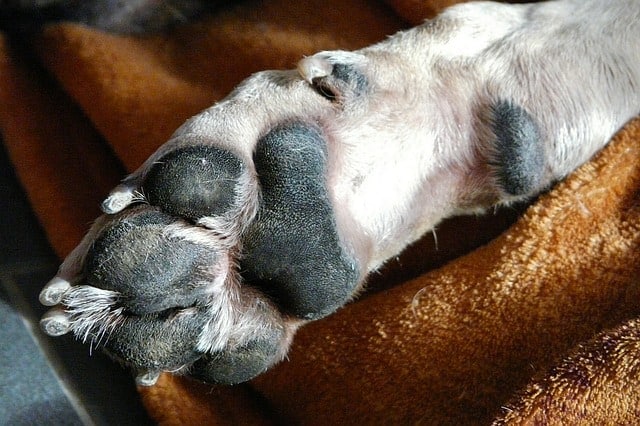
2. Scratching Wood with Their Claws
Dogs (as well as cats) may scratch up the wooden parts of chairs, tables, ottomans, and couches as they climb up and down. Don’t forget windowsills and doors too! Leather materials can also be particularly susceptible to dog scratches. While there are a few strategies to fix leather scratches from your dog, you’ll be better off just avoiding leather furniture altogether.
3. Chewing the Furniture
Bored, frustrated, and anxious dogs may find the legs of your favorite chair fun to chew on. Some may also tug on the seams, tags, and corners of couches too.
4. Soaking Furniture with Saliva or Urine
Pets who drool excessively (*cough* Great Danes *cough*) can create large stains on couch and chair fabrics. Urine can also cause problems – even perfectly house-trained pets may dribble a few drops of urine on the couch when they come back inside.
5. Moving or Toppling Furniture
If you have particularly rambunctious pets, you may find that they push your furniture around. They may even topple small tables or chairs while playing.
This can be particularly worrying, as it may not only damage your furniture, it could represent a safety hazard for your pets. Additionally, pushing furniture around may scratch hardwood floors too.
Pet Friendly Furniture: What Kinds of Characteristics Should You Look For?
Now that we’ve identified the ways in which pets damage furniture, we can begin discussing a few of the things you’ll want to consider when picking out new stuff.
Some items will hold up to pets better than others will, so you can avoid a lot of future headaches by simply picking furniture that’ll hold up to your pets.
This means looking for furniture that exhibits the following criteria:
Easy-to-Clean Fabrics
Even the tidiest pets will occasionally get dirty or leave a few drops of pee behind on the couch, so you always want to select pet-friendly furniture that is easy to clean.
We’ll talk about some of the easiest fabrics to clean in detail below, but this essentially means picking furniture with synthetic, denim, or leather upholstery.
Pet Hair Resistant Fabrics
The pet hair sticking to your furniture not only looks bad, it can lead to odors too. In fact, it can even exacerbate your allergies, as the hair will be covered in your pet’s saliva (it’s actually the proteins in your pet’s saliva that probably trigger your allergies – not the hair itself).
Limit these problems by selecting pet hair resistant furniture with tightly woven upholstery.
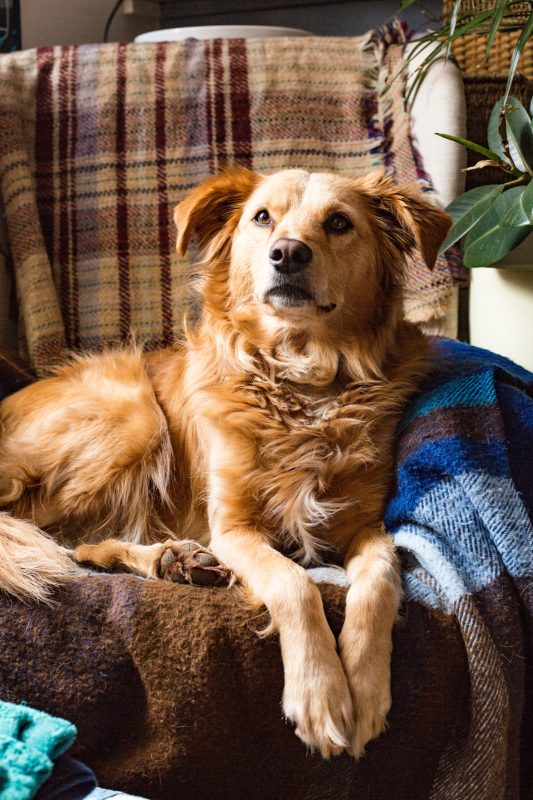
Durable Fabrics
Your dog’s claws will cause plenty of wear and tear on your furniture, so you’ll want to look for durable fabrics when picking out pet resistant furniture. Simply put: Avoid silk and linen, and opt instead for things like denim, canvas, or leather.

As Few Seams as Possible
When dogs decide to chew on fabric-covered items like your furniture, they often start at a seam or corner. All furniture upholsteries will have seams but avoid those that have unnecessary seams included for aesthetic purposes. This will likely reduce your dog’s desire to chew a bit.
Thick Finishes
The wooden portions of your furniture will usually be covered in stain or paint and some type of water-proof sealant, such as polyurethane or varnish. These finishes will help protect the wood from claws and body fluids, so try to select furniture that bears a high-quality finish.
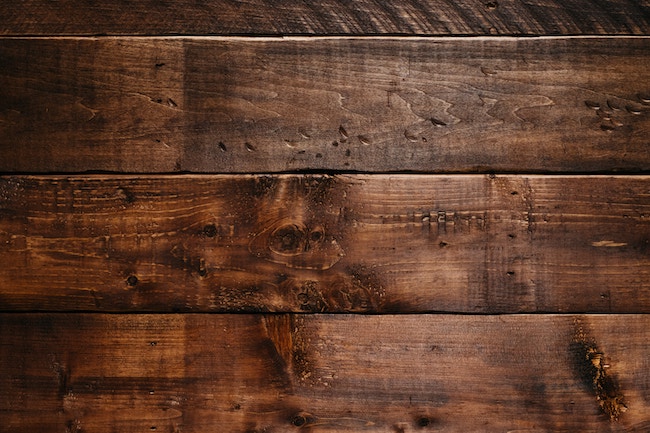
Similar Color to Your Pet’s Hair
One of the simplest ways to keep your furniture looking good is to select items that are colored like your pet. Have a chocolate lab? Get a dark brown sofa. Have a black-and-white border collie? Get a black-and-white recliner. Additionally, patterned fabrics will usually show hair and scratches less than solid-colored fabrics will.
Note that you may not be able to find furniture that meet all of these criteria. Just think about the ways your pet is most likely to cause trouble (or already has, if you are buying replacement furniture) and select fabric that’ll prevent these types of issues.
For example, you may not have to worry about your Chihuahua’s claws ripping up your new couch if he’s a chill little dude, who doesn’t mind having his nails trimmed frequently. Instead, your biggest problem may be selecting a couch with dog proof fabric that won’t be ruined when he has one of his accidents.
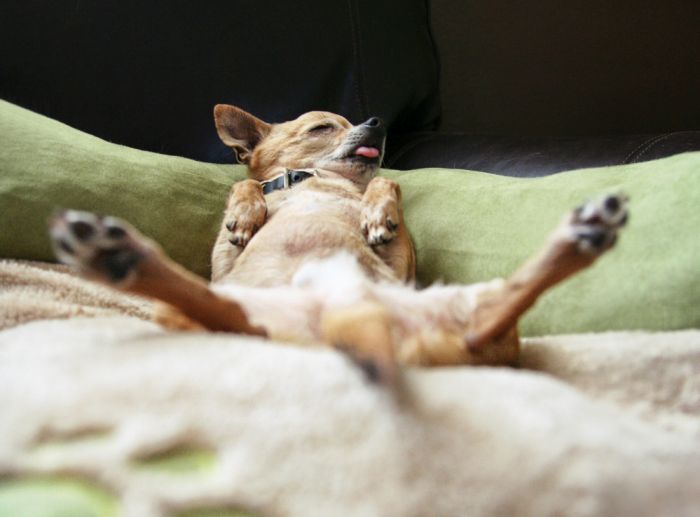
Alternatively, your golden retriever may not be accident-prone, but his heavily shedding coat may cause significant problems. In such cases, you’d be better served by selecting a couch that is easy to rid of hair.
Best Couch Materials For Dog Owners: Which Fabrics to Choose
Although most pets are equal-opportunity furniture destroyers, who are willing to ruin anything you bring home from the furniture store, your couch will usually bear the brunt of the damage they dole out.
Consequently, you’ll want to be particularly careful when picking out a new couch. Specifically, you’ll want to be sure to select one that is made from the most dog-proof couch material available. There are a ton of different options on the market, but we’ll discuss a few of the ones that work best for pets below.
→ Denim
Denim may not be the fanciest upholstery material around, but it’s extremely durable (hence its use in blue jeans). It’s usually not a big deal to wipe pet hair off of denim, and little droplets of drool and pee won’t stain it. Additionally, because it features a pretty tight weave, it isn’t as likely to snag your pet’s claws.
Many manufacturers use distressed or “acid-washed” denim when making furniture. These types of denim couches will help downplay any scratches or stains that occur.
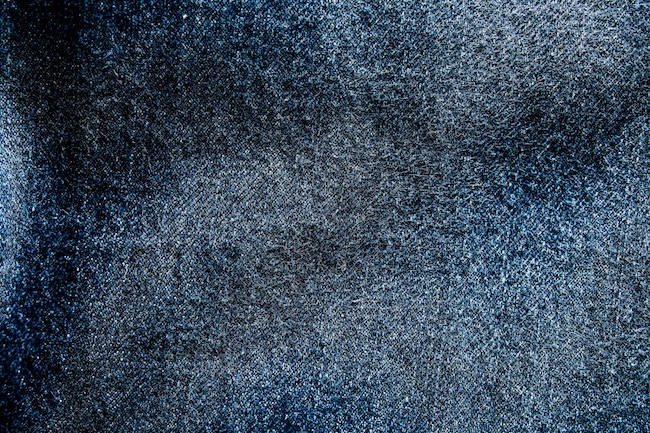
→ Canvas
Like denim, canvas is a humble, yet durable fabric that works well with pets. Canvas couches will usually hold up to your pet’s claws, and body fluids aren’t likely to ruin it. Unfortunately, canvas isn’t used for a lot of indoor furniture, but it is a common choice for patio and outdoor furniture.
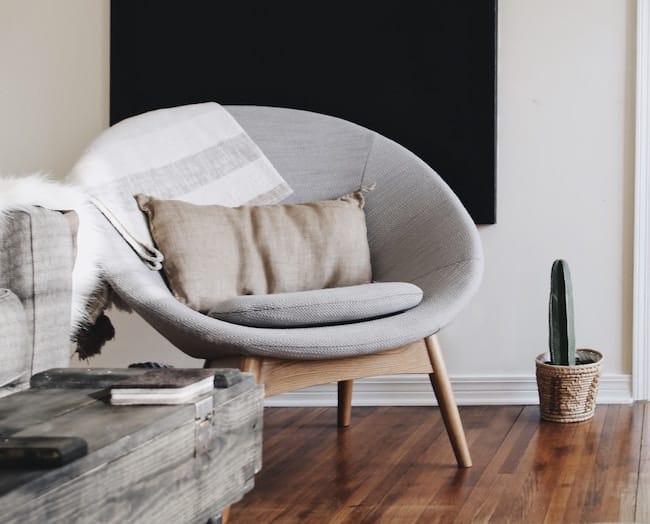
Canvas is more commonly used in the manufacture of furniture covers than the actual upholstery of couches and chairs. Canvas works marvelously in such applications, but we’ll talk about furniture covers a little later.
→ Synthetic Fibers
A variety of different synthetic fibers are used to make pet-proof couches, including polyester, nylon, and acrylic.
Many of these materials are used to create microfiber fabrics, which are some of the best options for pet owners. The term “microfiber” simply refers to the fact that the fibers used to make the fabric are extraordinarily thin – most are less than one-fifth the diameter of a human hair.
Some synthetic fibers are also used to create microsuede, which is another good option for pet owners. Microsuede looks and feels like genuine suede, but it doesn’t stain like real suede does and it is much easier to clean too.
→ Leather and Pleather
Leather and fake leather (pleather) are both pretty good choices for pet owners. Both are pretty durable fabrics that are easy to clean, and neither will collect pet hair – you can usually keep them looking great by just wiping them down with a damp rag (but always follow the care instructions provided).
However, your pet’s claws will scrape, scuff, and scratch these materials over time. This usually won’t ruin the function of the fabric, but it may compromise the aesthetics.
That said, some people actually like this kind of “weathered” look. You can even purchase “distressed” leather, which looks like it’s already been scuffed up – this will help deemphasize any marks your pet causes. This makes it a great choice for pet-friendly leather couches – the markings your dog adds with his claws will simply add character to the already distressed look.
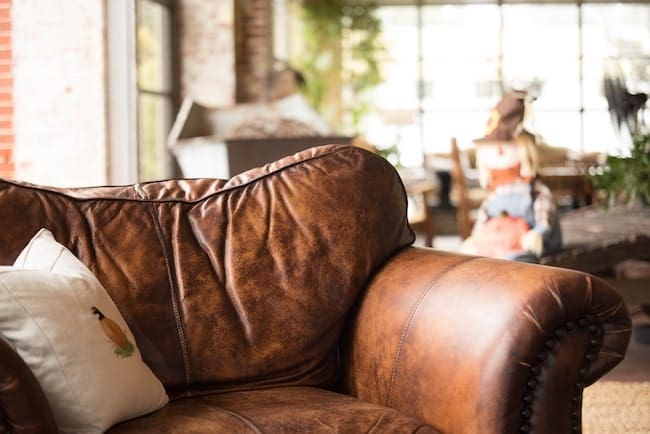
Note that while leather and pleather can work well for pets, suede is not a good choice as it stains easily.
Best Couches For Dog Owners: Top Picks
There are actually a few couches specifically designed with pet owners in mind – we’ll detail them below!
Burrow Nomad Fabric Sofa
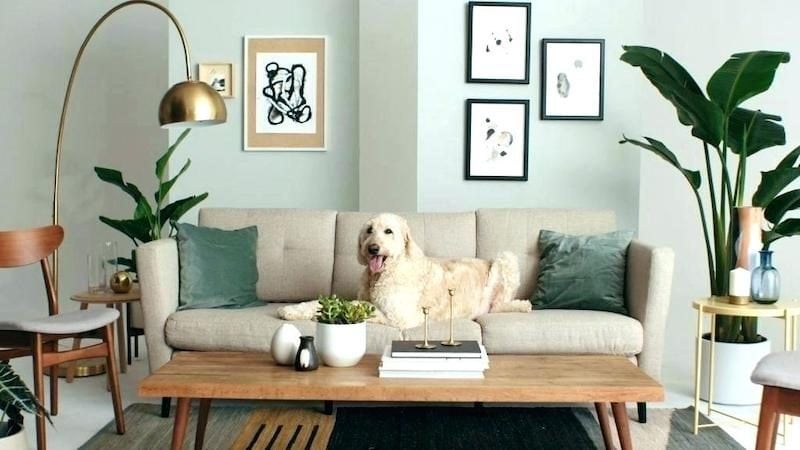
The Nomad Fabric Couch comes from the furniture company Burrow, who creates stylish yet durable sofas designed to be stain-resistant, scratch-proof, and pet friendly!
Burrow couches are handcrafted in North Carolina and are made from tightly-woven olefin fiber. This special fiber is naturally stain-resistant and more durable, making it tougher for dog claws to scratch up.
Burrow even experimented with real-world tests, simulating wear and tear by 3D printing fake animal paws with long claws. These claws were attached to a drive shaft and rotated in a circular pattern repeatedly across the couch with varying amounts of pressure and force to test resistance to different sized animals.
The result? The Burrow couch was able to withstand 2,000 scratches from a small dog and 200 from a large dog in the exact same spot, without showing any wear and tear! Very cool.
Couch cushions are made from non-toxic material, which means if your dog develops the not-so-unusual behavior of licking the furniture, you don’t need to worry about your pup ingesting nasty chemicals.
Couches are shipped for free and disassembled in a few different boxes, allowing pieces to easily be maneuvered up stairways and into apartments.
Despite coming disassembled, buyers note that they are very easy to assemble, snapping together in just a few steps. No stressful Ikea-style instructions, just click together a clips and you’re done.
The modular shipping makes the total shipping cost much less than traditional couch shipping (in fact, Burrow shipping is free)!
As a special discount for K9 of Mine readers, you can get 5% off orders of $500 or more with promo code K9OFMINE
Features:
- 5 fabric color options (white, red, dark grey, light grey, blue)
- Scratch and stain-resistant fabric + non-toxic materials
- Reversible cushions
- Built-in USB charger
- Choose between low or high arms
- Three options for wooden leg colors
- Option to add chaise or ottoman
- Free 2-4 day shipping
- Get free swatches if you can’t decide on color
- Competitive pricing with traditional couches
PROS
Buyers are very pleased with the quality and style of Burrow. Several folks note that these couches are so much easier to put together than other arrive-in-a-box sofas. One owner was particularly impressed when her dog threw up on the couch, only to have the mess wipe right off with no stain at all. She’s convinced it’s wizardry. Many also note that they love the bonus feature of the built-in USB charger.
CONS
One buyer wishes the ottoman was attached so it wouldn’t slide away from the couch. Some also felt that the weave was loose and caused snags, but most pet owners and apartment-dwellers seemed to love Burrow and had no issues.
What Types of Couch Fabrics Should Pet Owners Avoid?
There are also a few materials at the other end of the pet-resistant spectrum, which you’ll want to avoid at all costs.
- Silk is a laughably bad choice for homes with pets (or kids, for that matter). Even tiny claws will damage the delicate fabric, and it may become stained from your pet’s urine or saliva. Silk is also tricky to clean – you’ll often need professional assistance to do so.
- Linen stains and wrinkles easily, so it is also a bad choice for homes with pets.
- Wool, chenille, and tweed will collect pet hair like Velcro, so neither is a good option, and velvet is also a poor choice, as it is difficult to clean and easy to damage.
Protecting and Maintaining Your Furniture: Winning Strategies
Aside from picking furniture made from pet-safe materials, you can also employ a few furniture-protecting strategies that’ll reduce the amount of damage your pet inflicts upon your stuff. You may not be able to embrace all of the tricks discussed below but try to employ as many as you can.
1. Use Dog Proof Furniture Covers
One of the easiest ways to protect your furniture is by using durable dog proof furniture covers. In fact, furniture covers will usually protect against all of the types of problems pets often cause, including scratches, shed hair, and drool. They’ll even protect your stuff from drops of urine (they won’t, however, protect your furniture from pets that actually urinate on your stuff).
You can usually find furniture covers to fit just about any chair or couch, and most are made of resilient and easy-to-wash fabrics like canvas. Furniture covers don’t always look awesome, but they’ll keep your furniture in tip-top shape for when company comes over.
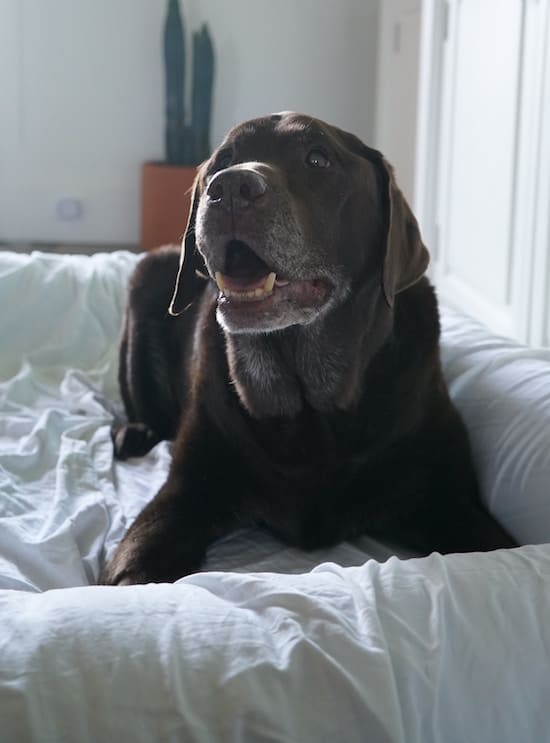
2. Apply a Stain-Repellent
Stain repellents, (like this one from Scotchgard), are often helpful in protecting your furniture from pet-related stains. They won’t prevent scratches, but they will help make it easier to clean your couch after your dirt-covered dog jumps up on it. They’ll even help to prevent bodily fluids from soaking into the fibers.
3. Purchase a Lint Roller
If pet hair is the primary problem you’re trying to deal with, you may find that a lint roller makes it easy to clean your furniture. Just roll the tool over the fabric covering your furniture a few times a week and you’ll be surprised how much cleaner it looks.
Note that this is only an effective strategy if you use the lint roller relatively regularly – if you wait until the couch is completely coated in fur, you’ll end up running out of the double-sided tape used in lint rollers very quickly.
If you’re currently experiencing a company-is-coming-over emergency, you can just wrap a little duct tape around your hand (sticky side out). Pat down the couch with the tape and you’ll be able to remove the majority of the hair.
4. Brush and Bathe Your Dog Regularly
Properly grooming your dog will help keep your furniture looking better for longer. Not only will this help eliminate odors, it’ll ensure that dirt and other contaminants on your dog’s fur won’t soil your favorite couch or chair.
Additionally, regular brushing and bathing will help rid your dog of soon-to-be-shed hairs. This will reduce the amount of hair that ends up sticking to your furniture.
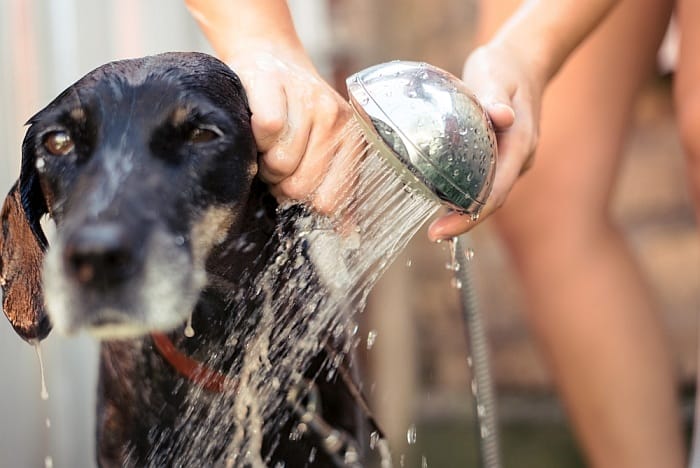
You can brush your dog as often as you like (most dogs enjoy being brushed), just do so outside to help limit the mess. You don’t want to bathe your dog too often though, as this can cause skin and coat problems. Generally, a once-a-month schedule is appropriate.
5. Use Protective Garments with Incontinent Canines
If your pet has a problem controlling his bladder, you may want to consider picking up an incontinent dog bed and a belly band (or, doggie diapers, in the case of a female dog with pee-pee problems).
There are a variety of belly bands on the market, including both disposable and washable varieties. Just check out our belly band buyer’s guide to see some of the best options available.
6. Prohibit Your Dog from Getting on the Couch
There is one final strategy you can use to protect your furniture: Just keep your pet off your furniture entirely.
This isn’t always easy to do (we’ll explain a few tips for doing so below), but if you’re successful, you don’t have to worry about your pet ruining your furniture. Some of your pet’s hair will still end up on the furniture, but not nearly as much as if you let your pooch sleep on the couch.
Nevertheless, this isn’t an ideal solution for all owners. Some people may feel bad about prohibiting their pet from sitting on the furniture. I’m firmly a member of this camp. I’d feel like a jerk for telling my dog she can’t snooze on the sofa – as far as I’m concerned, she can sleep where she likes.
But we all relate to our dogs differently, and this may be a good option for you.
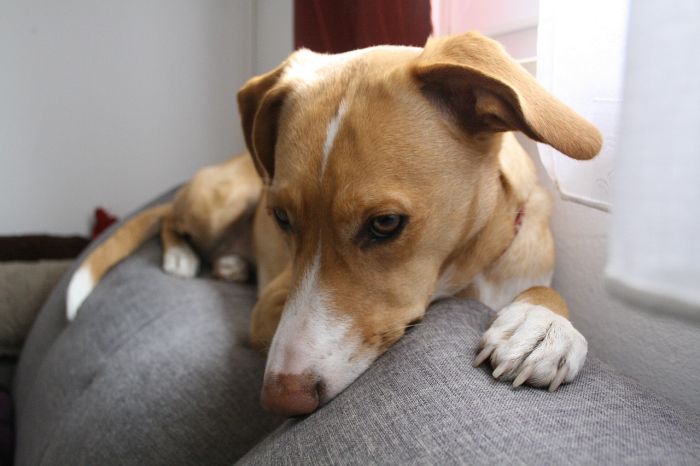
Addressing Specific Furniture Pet Problems
There are a number of specific furniture-related problems pet owners struggle with. We’ve tried to address some of these challenges and provide helpful solutions (such that they exist) below.
How do I protect my leather couch from dog scratches?
Leather works pretty well for homes with dogs, but it can become scuffed up from your dog’s claws. You could try to protect your furniture by forcing your pet to wear protective booties, but this may not be terribly practical on a day-in-day-out basis.
A better option is to simply keep your dog’s nails filed down. Don’t clip the nails – when you do, you end up removing one large point by creating two slightly smaller points (corners). Instead, use a grinding tool to round the tips of your dog’s nails. Do a good job and your dog probably won’t scratch your leather furniture much at all.
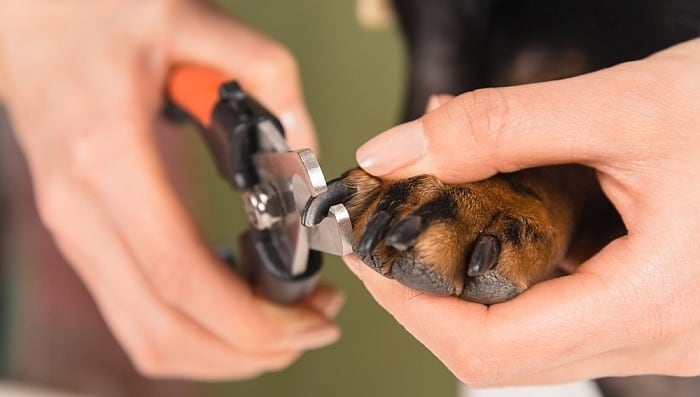
Some dogs are reticent to have their nails filed in this way, but many will learn to enjoy the process over time. Just start slow and reassure your dog during the process. You may even want to do his front paws at one sitting, and then do his rear paws later.
How do I get my dog to stop chewing on furniture?
Without a doubt, chewing damage is the worst thing that can happen to your furniture.
It’s hard to repair this kind of damage and it may even cause health problems for your pet if he ends up swallowing pieces of your couches or chairs. Unfortunately, this can also be a difficult problem to avoid.
I’ve dealt with this problem personally, as one of my former pooches would chew up anything she could get her mouth on – including the upholstery and legs of two different couches.
You can try using chewing deterrent sprays (assuming they won’t damage the fabric – always test anti-chewing sprays on an inconspicuous part of your furniture before using them to treat visible portions of the fabric), but this will require you to re-apply the spray regularly.
Instead, the best approach is to address the root cause of your dog’s destructive chewing habit. Many dogs chew because they are anxious or frightened, while others do so out of boredom or frustration. Young puppies will chew on things to help alleviate the pain and discomfort associated with teething.
If your dog is anxious, you may want to consider providing him with a secure crate, which may help him feel safer. You could also try fitting him with a tightly-fitting garment, such as a Thundershirt, as these often help alleviate anxiety and fear.
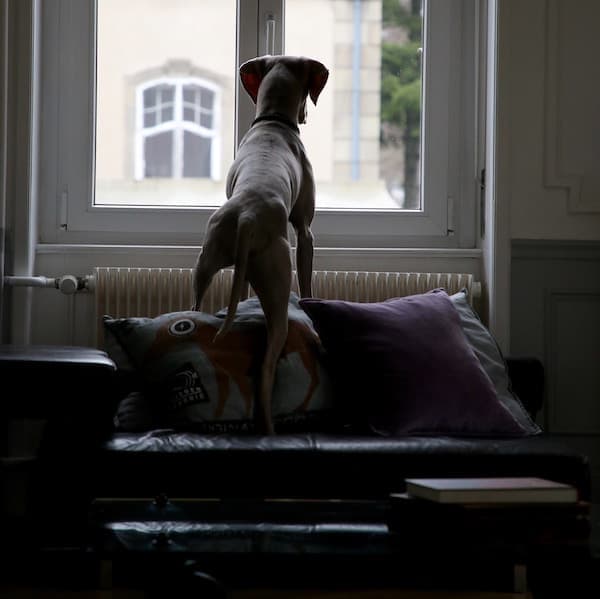
On the other hand, if your dog is chewing up your furniture because he is bored or frustrated, you can provide him with interactive or treat-dispensing toys to help keep his mind occupied. It will likely be helpful to provide him with more opportunities to exercise too. After all, a tired dog is a well-behaved dog!
How do I protect my furniture from dog urine?
Urine can ruin an otherwise-perfect piece of furniture. It’ll not only leave a visible stain, but it’ll leave behind a terrible odor as well. Unfortunately, there aren’t a lot of easy ways to protect your furniture from urine.
The best solution is likely to fit your pet with a protective garment, such as a canine diaper or belly band – especially if the problem occurs often. This is really the only way to protect your stuff from full-blown urination.
On the other hand, if you’re more concerned with protecting your furniture from tiny amounts of urine, furniture covers are a viable option. They’d likely absorb a few drops of urine before they can soak through to the fabric below. Moisture- and stain-repelling sprays (such as those referenced earlier) may also provide some value.
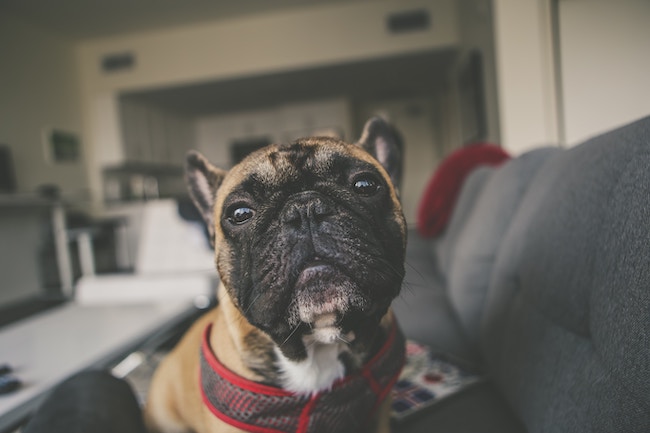
How do I get my dog to stop digging in the couch?
Some dogs have a habit of “digging” before they lay down.
This is presumably an evolutionary artifact left over from their wild ancestors, who would have to paw at the ground to make a comfortable place to lay. Some dogs also “dig” into couches or chairs as part of their bone- or treat-burying behavior.
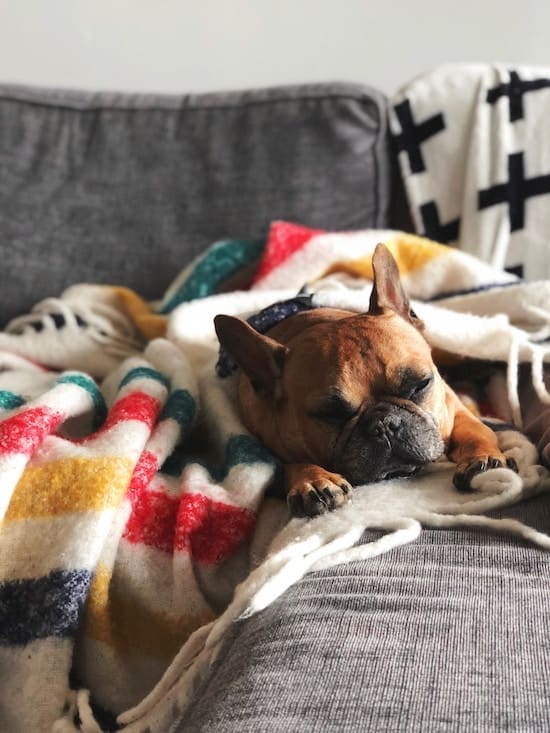
Both behaviors can be challenging to stop, as they don’t always occur regularly (thereby preventing you from stopping or redirecting them in the act).
The best thing to do is to watch your dog carefully when giving him treats or chew toys, so you can stop him if he starts trying to bury it in the couch cushions. Preventing “bed-making” scratching can be trickier to stop, so you may simply have to fit your furniture with a protective cover.
How do I keep pet hair off my furniture?
Keeping your pet’s hair off the furniture generally requires a two-pronged approach.
First, start by buying furniture made from pet proof materials that are unlikely to collect dog hair. This means avoiding things like wool and tweed, and instead opting for things like leather or microfiber.
Secondly, you’ll want to try to remove as much of your dog’s hair as possible in a controlled manner. For example, you can bathe your pet in the bathtub, which will knock off most of the hairs he’s about to shed (as well as those that he’s already shed but haven’t yet fallen to the ground). You can also brush your pet’s hair before allowing him inside, which will accomplish the same thing.
Note that if your dog sheds excessively, you may want to consult your vet to ensure he’s not suffering from a health problem. It may also be wise to switch to a food that features omega-3 fatty acids, as these tend to promote good coat health and reduce shedding slightly. You can also find standalone omega-3 supplements if you don’t want to alter your dog’s diet.
Other Pet-Friendly Furniture Considerations
While you want to think about the ways your pet may damage furniture when picking out a new couch or chair, it also makes sense to think about the ways your pet will enjoy your new furniture too (assuming you intend on letting him sleep on your new sofa).
Some of the things you may want to keep in mind when picking out new furniture include:
- Try to pick furniture that sits close to the ground if you have a tiny pet. It can be difficult for small dogs to jump up on tall couches and chairs, so try to pick something that won’t force your pup to pole-vault anytime he wants to take a nap.
- Avoid excessively soft cushions. While people often like couches and chairs that allow you to sink down when you sit and provide a bean-bag-like experience, these types of furniture can be tricky for pets to walk on. Additionally, they will usually fail to provide the type of support your dog wants when sleeping.
- Avoid slippery fabrics. Most smooth-and-silky fabrics are unsuitable for pets because they’re easy to damage, but they also make it difficult for dogs to walk around and feel safe while doing so. This may even increase the chances that your dog will dig in with his claws to avoid slipping. Instead, select furniture that has a bit of texture to it.
- Use caution when picking recliners and other types of moving furniture. No living room is complete without a reclining chair, but you must be careful when selecting one if you have pets. Your pet may inadvertently cause the chair to recline, which may cause him to panic a bit. He may end up knocking the chair over or – in a worst-case scenario – becoming trapped or injured by some of the moving parts.
***
It can be a challenge to pick out furniture that’ll stand up to the indignities your pet inflicts upon it, but if you heed the advice provided above, you’ll likely be able to find some furniture that works for you and your four-footer.
Tell us about the furniture you use in your home. Have you found a couch or chair that has held up exceptionally well? Do you prefer one fabric over another? Let us know about your experiences in the comments below.
I’m not particularly fancy when it comes to furniture. I have a 10-year-old pleather couch that suits me and my pooch just fine. She’s scratched it up a little, but I’ve probably damaged it more than she has over time. When the time comes, I’ll likely go with another pleather couch, unless I become rich and decide to go with real leather.
However, I will likely look for distressed pleather or leather when I do to help de-emphasize the scratches my pooch causes and keep it looking its best.
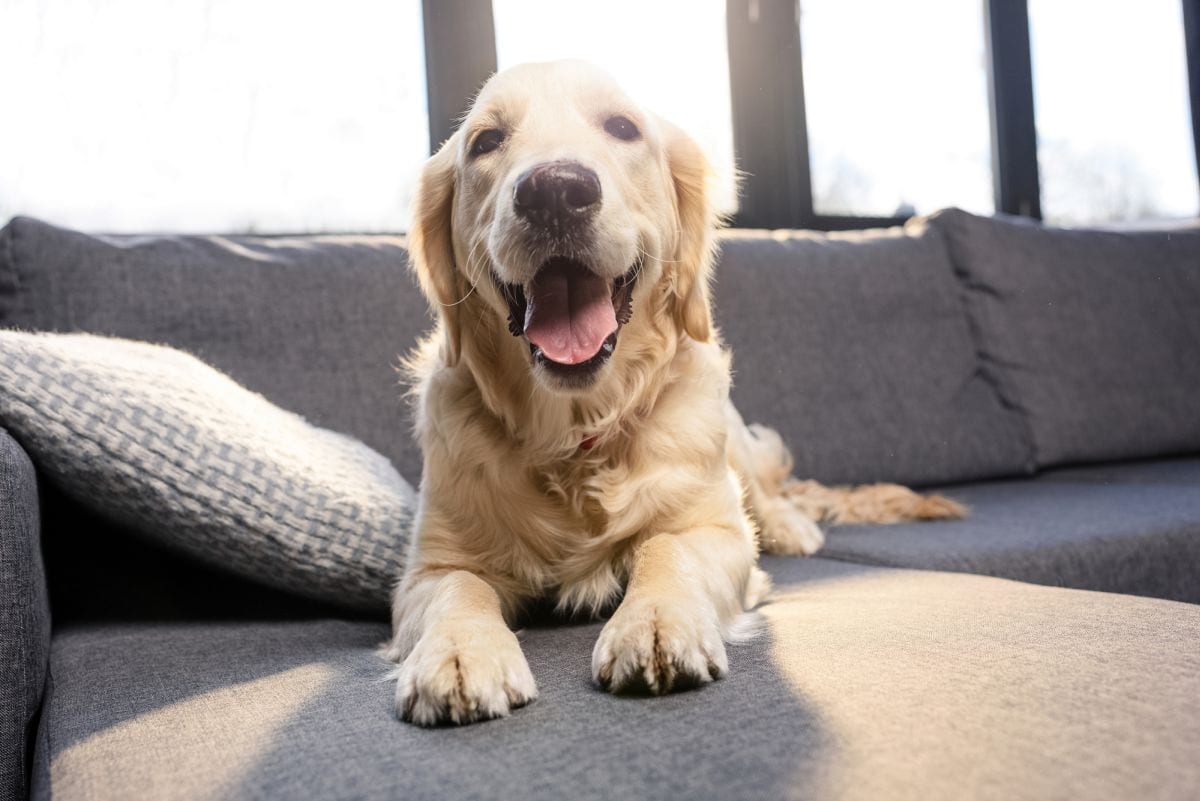



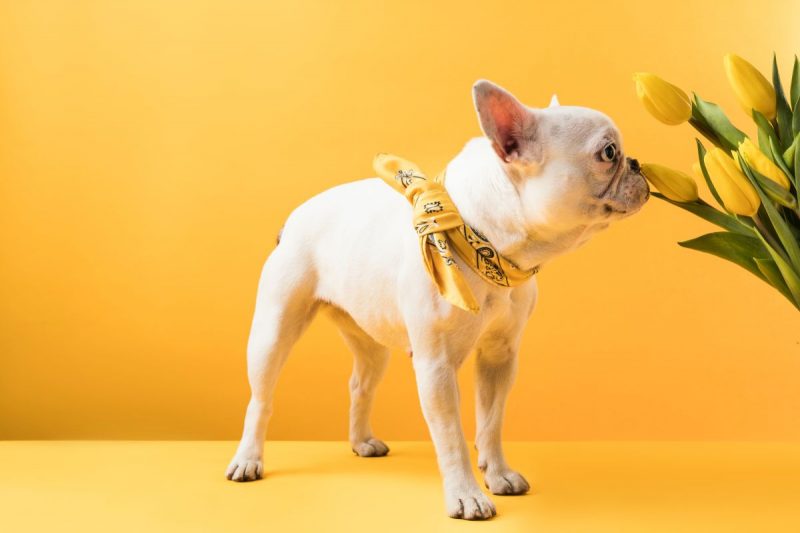
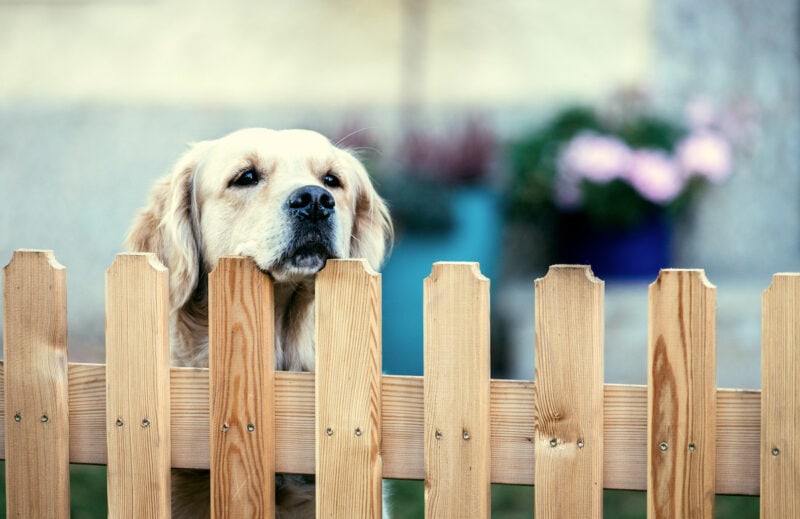
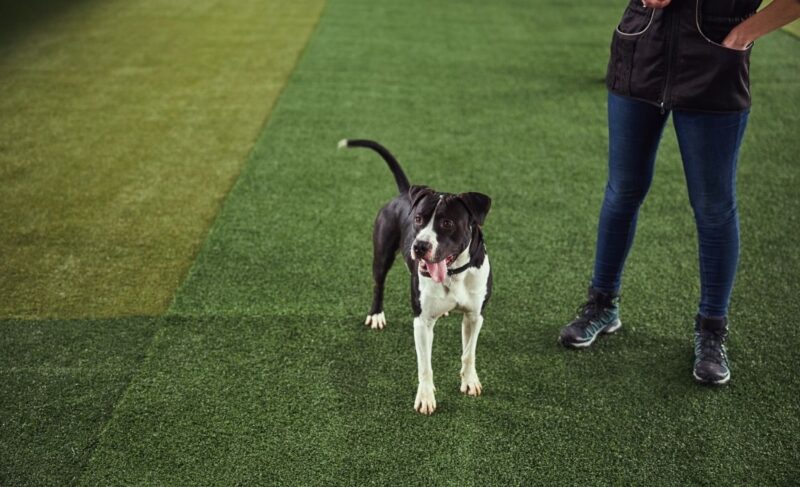

Leave a Comment